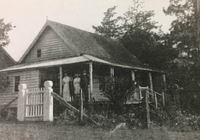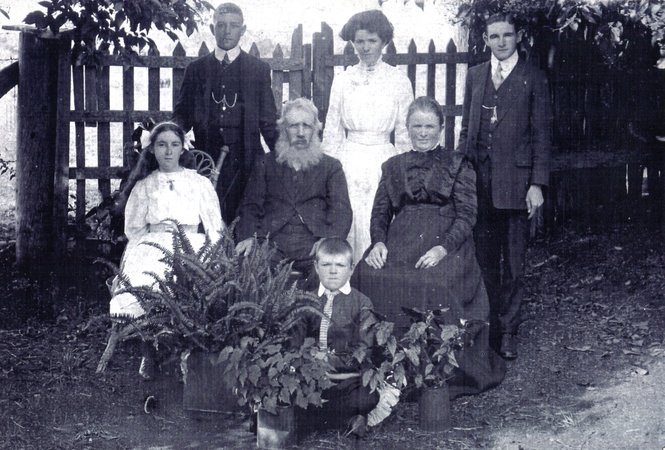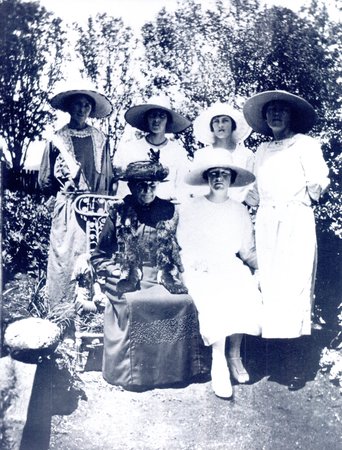Patrick Shea (1834 – 1916) was born in County Clare, Ireland. He arrived in Queensland in 1858. He first settled at Pilton then moved to Drayton after his marriage to Bridgett O’Connell in 1859. Patrick’s work included shepherding, timber cutting, fencing and dairying. In 1878 Patrick and his family moved to Southbrook where he took up Rockmount Station. Patrick died in 1916 and is buried with Bridgett in the Toowoomba and Drayton cemetery.
On 28 December 1934, Patrick Shea was born at Knocknakilla in the Parish of Inagh, County Clare, Ireland to parents Michael Shea and Bridgett Boland who were farmers. Patrick left for Australia at age 23 on the Joshua, arriving in Sydney on 6 April 1858. The voyage lasted 97 days from its departure from Southhampton at the end of December 1857. He travelled to Moreton Bay by coastal boat and then on to Ipswich by riverboat. Finding that the only available work was on pastoral holdings west of the Great Divide, he travelled to Pilton via Drayton by road where he found work at Pilton Station. Patrick’s first home was a tiny slab hut, and his work included shepherding the flocks, cutting timber, building yards and hurdles and fencing paddocks. His meals consisted largely of mutton and damper.
Bridgett O’Connell arrived in Moreton Bay on board the Shackamaxon on 24 November 1859, just two weeks before the separation of Queensland from New South Wales. She had been born in 1840 in the parish of Kilmaley, which adjoins the parish of Inagh where Patrick was born. Her parents were John O’Connell and Honora Markham. The following extract of an article in the Moreton Bay Courier on Saturday 26 November 1859 announcing the arrival of the Shackamaxon, underlines the desperate need for labour in the colony:
The immigrants will be for hire on Monday next, and the particulars of the different callings are given in our advertising columns. In mentioning this, we feel bound to refer to the obstinate violation of rule by any persons, who, in spite of all that may be said to them, persevere in entering the depot, and engaging servants previous to the time advertised. It is unfair to the public, and especially to those residing at a distance, for any individual to tamper with the immigrants prior to the advertised day, and we know that a stringent system of exclusion is maintained in Sydney and elsewhere.
The same edition mentions the preparation for the arrival of the first Governor of the new colony, who was due to arrive the next week.
Patrick travelled to Ipswich to meet his fiancée. A month after her arrival, on 28 December 1859, they were married by the Reverend Father McGinty at St Mary’s church. The marriage certificate is printed with the heading ‘Colony of New South Wales’ and has the last three words crossed out and ‘Queensland’ annotated above. Theirs was one of the first marriages to be registered in the new colony, just a few weeks after separation.
The newlyweds travelled up to Pilton in a loaded bullock dray carrying goods to the Downs. Their first five children were born at Pilton. The first was Daniel Patrick in 1860, followed by Julia, James, Ellen and lastly Michael Joseph in 1865. James lived less than a week and Ellen just 11 months. A family story has it that after the death of one of these two children, Patrick wrapped up the body and loaded it onto his horse to take it off to bury it. He stopped on the way to have a drink at the pub. After some time, the horse tired of waiting outside and returned home by itself still carrying the dead newborn, much to the shock of the family.
In 1865, Patrick and Bridgett brought the family from Pilton to Drayton in order that the children could get an education. Patrick purchased land that he had intended to farm, but conditions were very different to those of County Clare, and the land was unable to support his family. Often Patrick found it necessary to do any other work that was available such as clearing, fencing and building. In 1866, he worked on the shingled roof of the Catholic Church. He worked for the Government for a time, as a ganger constructing roads and bridges. Later Patrick was engaged in sawing sleepers with a pit saw for the Toowoomba to Warwick railway line, which was completed in 1871. In 1874 he built a house, which is still standing on the western outskirts of Drayton. Patrick built the house himself using hand-hewn timber. He also made most of the furniture.
In the meantime, Bridgett and Patrick’s family continued to grow, with nine more children born between 1866 and 1879. They were Martin, James, Ellen, Francis, Patrick, David, Mary Elizabeth and finally Robert in 1879. Bridgett had given birth to 14 children over 19 years.
With the family growing up and the Drayton land limited, conditions were not the best for a large family. Father Patrick Dunne, a keen proponent of Irish migration to Australia, was parish priest of Drayton and Toowoomba at that time. Dunne often read out land sale notices during mass, encouraging the take-up of the land on offer by his Irish flock. In 1878, acting on the advice of Father Dunne, the O’Shea family moved to Southbrook. Patrick took up Rockmount for himself and the adjoining Fairview for his eldest son, Daniel, who was then 19 years of age. Patrick again built his house and furniture, shaping the timber with his axe and adze.
Patrick was enthusiastic about land settlement and encouraged and assisted others in taking up land. Bridgett’s brother, Patrick O’Connell, had travelled to Australia in 1862 on the ship Conway. He took up another Southbrook property, Barefields. Members of these families and other immigrants were pioneers of the dairy industry at Southbrook.
At Rockmount up to 40 cows were being milked as early as 1818. The milk was set in pans and hand skimmed. Butter was made by hand and carted to Toowoomba by horse and cart over a distance of 22 miles (about 35 kilometres), up to three times a week. The railway line through Southbrook to Pittsworth was finally completed in 1887.
Patrick and Bridgett retired in 1911 and lived in Drayton with their daughter Mary, leaving Rockmount in the capable hands of their son, David, along with his brothers Francis and Michael. They had played a great part in changing the area from bushland to a prosperous agricultural district.
Patrick passed away on 11 December 1916. Bridgett lived another eight years, until 6 January 1925. She was aged 86. Her obituary spoke of her kindly nature:
The kind old lady lived many years both in Drayton and in Southbrook and was always a friend to everyone. Her neighbours always spoke in endearing terms of her. To know her was to love her.
Patrick and Bridgett are buried together in the Toowoomba Drayton Cemetery.
Whilst Patrick and Bridgett’s children were registered with the surname Shea, the preferred version of O’Shea gradually supplanted Shea in formal records. Of Patrick and Bridgett’s 14 children, three died in infancy, six married and five remained unmarried. At the time of Patrick’s death, there were 27 surviving grandchildren.
Citation
Lee Butterworth and Paul Grenville, ‘Patrick Shea (1834 – 1916)’, Harry Gentle Resource Centre, Griffith University, 2018, https://harrygentle.griffith.edu.au/life-stories/patrick-shea/.
Books
Paul Granville, Queensland Founding Families: Biographies of families living in Queensland prior to separation from New South Wales, Vol. 2.
Queensland Family History Society, 2009.
Newspapers
Local Intelligence: New arrived immigrants, Moreton Bay Courier, 26 November 1859, p. 2.
Online Resources
NSW State Archives, Assisted Immigrants Index, Patrick Shea per Joshua (1858) to Sydney





